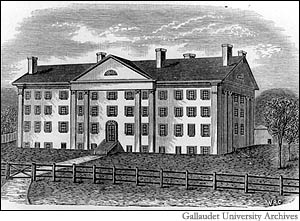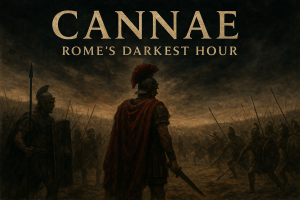During the 1800s, deaf people in America had no language they could use to communicate with other deaf people, or anyone else for that matter. They let others know their needs and wants through gestures and signs they came up with on their own. Some basic gestures, such as “yes” or “hungry,” were somewhat universal, but those signs only scratched the surface of what deaf people wanted to say. They were in need of their own language and of a way and a place to learn it, and although he was not deaf or hard of hearing, a man named Thomas Hopkins Gallaudet was the one who finally acquired it for them.
Thomas Gallaudet was a man of many talents. After graduating from Yale at seventeen, he worked as a law assistant and a tutor, but due to health-related issues, he left his job and became a door-to-door salesman in rural Kentucky and Ohio, where he schooled young children that couldn’t afford an education. He especially enjoyed teaching geography, U.S. history, and the Bible, which eventually lead to him discovering his own passion for religion. He earned his license to be a preacher, and became a traveling minister, going everywhere he felt there was a need. His constant traveling allowed him to visit his family in his hometown of Hartford, Connecticut on a regular basis.1

During one of his visits home, Gallaudet came across his neighbor’s daughter, Alice Cogswell, playing by herself. At the age of two, Alice had contracted meningitis, and as a result, lost her hearing.2 Her father, Dr. Mason Fitch Cogswell, explained to Gallaudet that his daughter was deaf and that she had trouble communicating with not only other children but also with her own family. Knowing that Gallaudet was a teacher, Dr. Cogswell pleaded with Gallaudet to help Alice learn how to speak, regardless of whether it was with her voice or her hands.3
Gallaudet agreed, and started teaching a simple form of sign language as best as he could. Nevertheless, both Gallaudet and Dr. Cogswell were deeply concerned with the lack of deaf education in America and set out to change that. The two them collected donations and support from their community, and soon enough, they had sufficient funds to send Gallaudet to Europe, to track down a sign language teacher.4
During his travels, Gallaudet came across an advertisement for a speech given by Abbe Sicard, the principal of a deaf institution in Paris, France. Gallaudet had previously known about him and his work, so he attended one of his speeches. After the speech, Gallaudet approached Sicard, and spoke to him about his troubles and worries over deaf education in America. Sicard listened intently to his woes and made the decision to invited Gallaudet to the institution he taught at, to take lessons under him. Gallaudet zealously accepted the offer, and went off to Paris with Sicard.5
In addition to taking classes with Sicard, Gallaudet also took private lessons with Sicard’s chief assistant, Laurent Clerc. Gallaudet was entranced by Clerc’s expertise in the sign language and begged him to come to America to teach with him. Clerc was skeptical, but Gallaudet was adamant. He worked hard to get Clerc onboard with his plan. Clerc eventually gave in and sought permission from Sicard to take a leave for his journey to America. Sicard was also initially wary of Clerc’s expedition, but also came around to the idea and granted Clerc the permission he asked for.6

On June 18, 1816, Gallaudet and Clerc set out for Hartford, Connecticut on the ship Mary Augusta, a journey that lasted fifty-two days. The two men used that time to exchange their knowledge of languages. Clerc continued teaching Gallaudet the vast array of signs that were included in French Sign Language, and Gallaudet helped Clerc to polish his English-speaking skills. On August 22, 1816, the day the Mary Augusta arrived in America, Laurent Clerc met Alice Cogswell for the first time. Although she did not know French Sign Language, Clerc “communicated with her through sign associations.” Clerc saw Alice had a strong will to continue to learn sign language, which fueled him in his quest to teach the deaf people of America a standardized nonverbal form of communication.7
Over the next couple of months, Gallaudet and Clerc traveled the United States. They spread information about sign language and deaf culture, met with potential students and their parents, and they began the process of establishing the first deaf school in America. They collected funds by taking donations from the public and from the Connecticut General Assembly also. They raised over $15,000 and they used that money to start what was “originally called the Connecticut Asylum at Hartford for the Instruction of Deaf and Dumb Persons (now the American School for the Deaf).”8 On the day of April 15, 1817, a little less than a year since Gallaudet brought Clerc to the United States, the school opened its doors to the public. Laurent Clerc was the first teacher and Alice Cogswell was the first student. The French Sign Language Clerc taught to his students eventually evolved to the dialect that deaf Americans still use today, American Sign Language.9

Although the school was good, Gallaudet and Clerc wanted to keep going. They went to Congress and got approval from the House of Representatives, Senate, and President Abraham Lincoln to granted college degrees from their school. Eventually, the American School for the Deaf branched out to form Gallaudet University, the first and only all-deaf university in the United States.10 Both the American School for the Deaf and Gallaudet University continue to provide proper education to those who are deaf and hard of hearing, proving a saying that prevails in deaf culture: Deaf people can do EVERYTHING a hearing person can do except hear.
- Katalin Enders, “Gallaudet, Thomas Hopkins,” 2003, Learning to Give (website), https://www.learningtogive.org/resources/gallaudet-thomas-hopkins. ↵
- “Alice Cogswell,” Scholastic. April/May 2012. ↵
- Carolyn Ball, The History of American Sign Language Interpreting Education (Minnesota: Capella University, 2007), 11. ↵
- Loida R. Canlas, “Laurent Clerc: Apostle to the Deaf People of the New World,” 2015, Gallaudet (website), http://www3.gallaudet.edu/clerc-center/info-to-go/deaf-culture/laurent-clerc.html. ↵
- Margret A. Winzer, The History of Special Education: From Isolation to Integration (Washington D.C.: Gallaudet University Press, 1993), 101. ↵
- Margret A. Winzer, The History of Special Education: From Isolation to Integration (Washington D.C.: Gallaudet University Press, 1993), 101. ↵
- Loida R. Canlas, “Laurent Clerc: Apostle to the Deaf People of the New World,” 2015, Gallaudet (website), http://www3.gallaudet.edu/clerc-center/info-to-go/deaf-culture/laurent-clerc.html. ↵
- Loida R. Canlas, “Laurent Clerc: Apostle to the Deaf People of the New World,” 2015, Gallaudet (website), http://www3.gallaudet.edu/clerc-center/info-to-go/deaf-culture/laurent-clerc.html. ↵
- Marc Marschark and Patricia E. Spencer, Oxford Handbook of Deaf Studies, Language, and Education (Oxford: Oxford University Press, 2003), 13-14. ↵
- Loida R. Canlas, “Laurent Clerc: Apostle to the Deaf People of the New World,” 2015, Gallaudet (website), http://www3.gallaudet.edu/clerc-center/info-to-go/deaf-culture/laurent-clerc.html. ↵



61 comments
Kasandra Ramirez Ferrer
I didn’t acknowledge the deaf community until I moved to the U.S, in my first year of high school is when I had the option to study ASL as a language credit. Taking this class taught me a lot of the community and even though people with hearing disability have more access to getting an education and opportunities, society has yet to recognize this community even more and teach people the importance of it because of the great number of people who aren’t able to hear.
James Disrud
This article is very interesting, I don’t personally know anyone that uses sign language but I was always wondered about the language and who formed it.Reading this gave me some good insight about it. Thomas Gallaudet played a major role in the origins of American sign language, he was a person that fought for sign language because he was a genuinely good person. This was very well written and gave me a better look back at the history of American sign language.
James Disrud
This article is very interesting, I don’t personally know anyone that uses sign language but I was always wondered about the language and who formed it.Reading this gave me some good insight about it. Thomas Gallaudet played a major role in the origins of American sign language, he was a person that fought for sign language because he was a genuinely good person. This article was well written and gave me a better insight of the history of American sign language.
Azucena Cuevas
I really enjoyed this article because it isn’t something you typically read about. It is amazing what Gallaudet was able to do for deaf people. It is admirable that even though he wasn’t deaf he wanted to help those who were communicate with everybody and among the deaf community. It was also interesting to read how Clerc and Gallaudet converted the school into a University for deaf people. I also think that American Sign Language should be offered more in all schools.
Joanna Martinez
It is remarkable that one man caused such a big impact all over the world. For years people who were deaf did not have a way to communicate and were forced to live without a language. Thomas Gallaudet completely changed the world and proved that people who are deaf can have just as much of a voice as those who have a voice naturally. Without his assistance on the matter, who’s to say there would be a form of communication between deaf individuals and their friends and family.
Alin Bocardo Felix
In high school, I took two years of American Sign Language, which included the hand signs, the formats, the culture, the history and Gallaudet himself. Thomas Gallaudet is a man of his word, a preacher that followed his beliefs and it is thanks to him and those that helped him that has allowed new deaf generations obtain the education they deserve. Being deaf is seen as such a stigma, but their culture and pride of it is what makes it worthwhile. For example, one must earn their name sign from a deaf person, meaning one must interact enough to create that bond. Furthermore, deaf people are already excluded by the means of majority, why is it so hard to open a flow passage and allow everyone to be together. Overall, the article is very informative and successfully includes the reasons behind the plan,and the aftermath of it.
Ariana Brown
It’s amazing to see what Galladaut and Clerc did for American Sign Language. I have never heard of how sign language became what it is today and how they fought in Congress for the rights of deaf children. Just to think where Alice would have been without having been given the opportunity to learn by Galladaut and Clerc as well as the future deaf children in America.
Sofia Martinez
I believe that Thomas Gallaudet changed America for the better, he had taught children and adults the language that is now universal thanks to many educators that help the deaf; without their help, there wouldn’t be a way for many people in the world to communicate. Gallaudet knew that it was becoming a problem that many individuals did not know how to communicate due to their disability. This is a very interesting and useful article as I did not know how the American Sign Language originated from.
Briley Perkins
I think this article was really interesting to read, because I know a couple of my friends that know sign language and always wondered who came up with the language in the first place. It is so cool that a man named Thomas Gallaudet helped form the language that is used all around the world and has changed communication for all deaf people. Great article!
Raul Vallejo
Inspiring to read about people who truly cared about the needs of others without any personal gain. Gallaudet and Clerc did not have to help those kids at all and the definitely did not need to go as far as they did and start a whole entire university. They genuinely just were good people that wanted to help those that couldn’t help themselves.